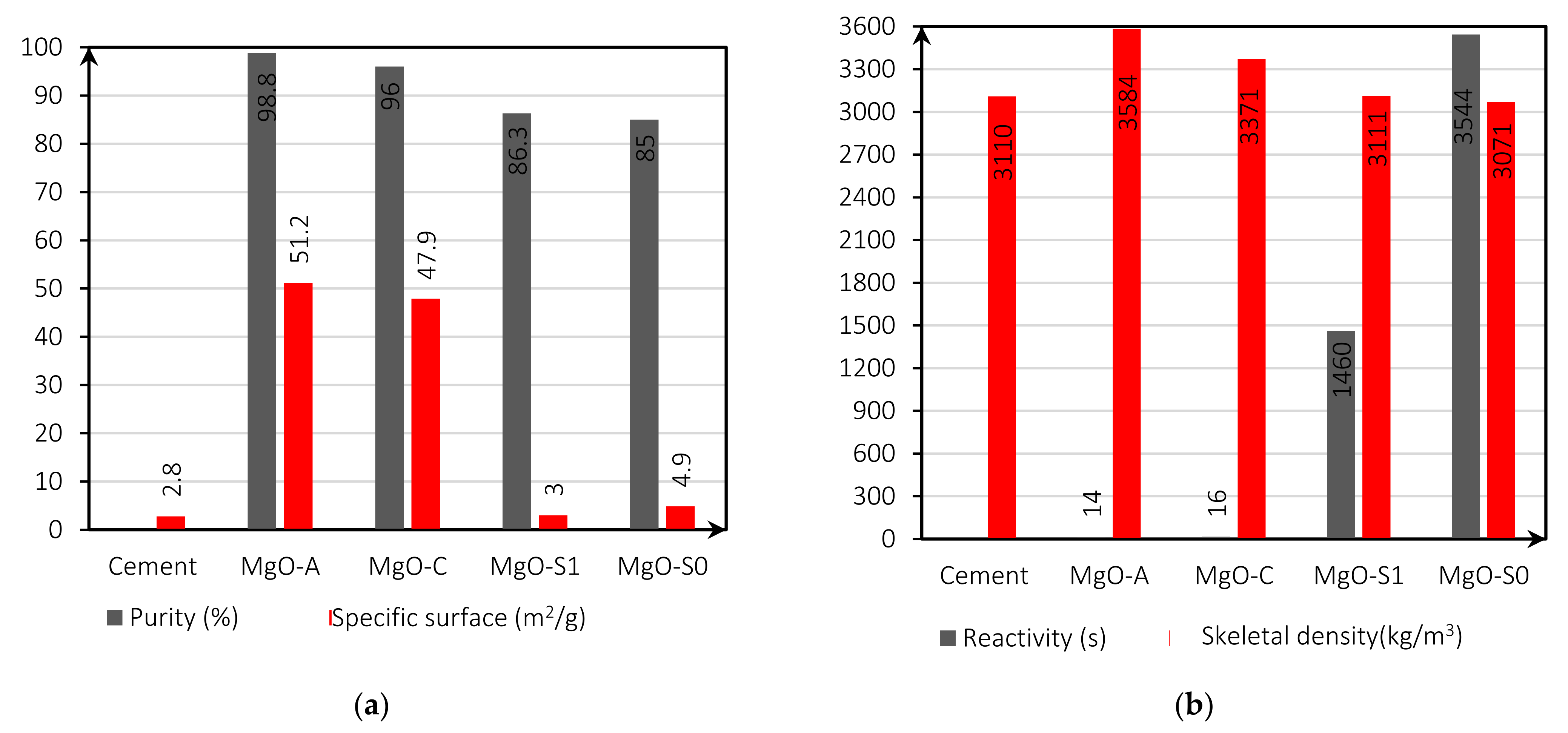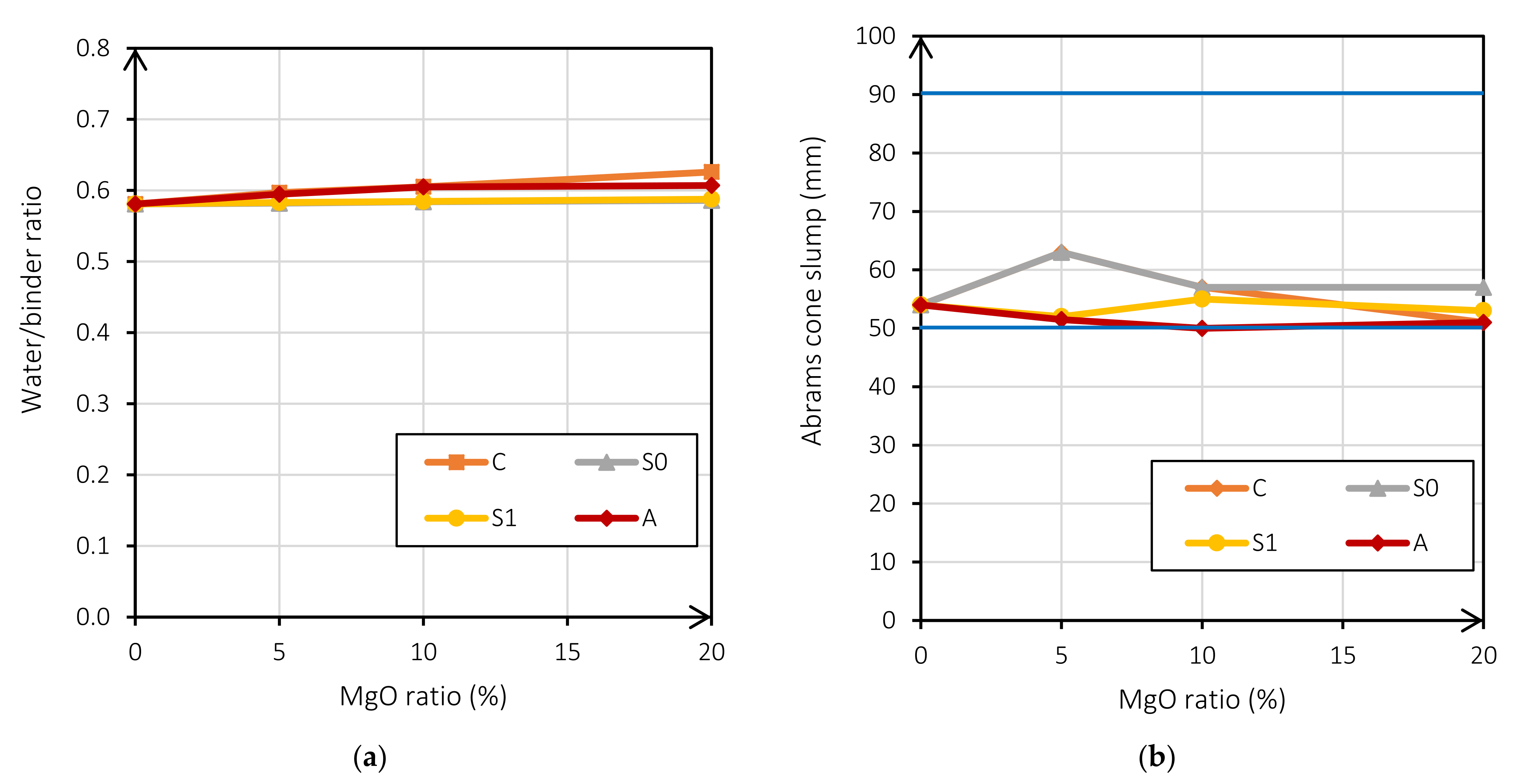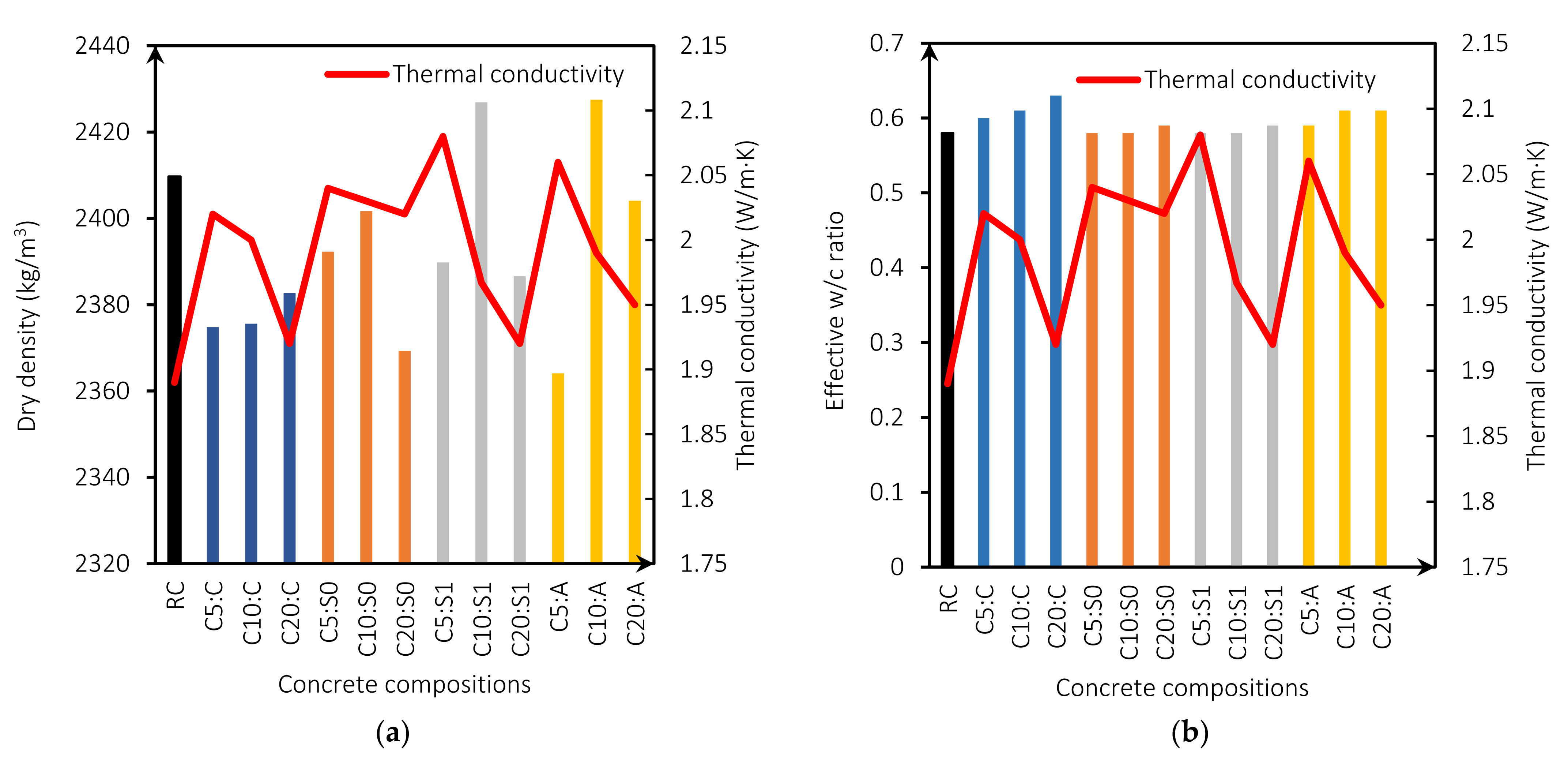Thermal Performance of Concrete with Reactive Magnesium Oxide as an Alternative Binder
Abstract
:1. Introduction
2. Materials and Methods
2.1. Experimental Procedure
2.1.1. Materials
2.1.2. Tests
2.1.3. Mixing and Mix Design
3. Experimental Results and Discussion
4. Thermal Conductivity
5. Relationships between Thermal Properties and Mechanical Properties
6. Conclusions
Author Contributions
Funding
Institutional Review Board Statement
Informed Consent Statement
Data Availability Statement
Conflicts of Interest
References
- Schleussner, C.-F.; Rogelj, J.; Schaeffer, M.; Lissner, T.; Licker, R.; Fischer, E.M.; Knutti, R.; Levermann, A.; Frieler, K.; Hare, W. Science and policy characteristics of the Paris Agreement temperature goal. Nat. Clim. Chang. 2016, 6, 827–835. [Google Scholar] [CrossRef] [Green Version]
- Nilsson, A.; Hans, F.; Lopez Legarreta, P.; Lui, S.; Röser, F. Decarbonisation Pathways for the EU Cement Sector; Technology Routes and Potential Ways Forward; NewClimate Institute: Berlin, Germany, 2020. [Google Scholar]
- Dean, B.; Dulac, J.; Petrichenko, K.; Graham, P. Global Status Report 2016: Towards Zero-Emission Efficient and Resilient Buildings; UN Environment Programme: Nairobi, Kenya, 2016. [Google Scholar]
- Andrew, R.M. Global CO2 emissions from cement production. Earth Syst. Sci. Data 2018, 10, 195–217. [Google Scholar] [CrossRef] [Green Version]
- Unluer, C.; Al-Tabbaa, A. Enhancing the carbonation of MgO cement porous blocks through improved curing conditions. Cem. Concr. Res. 2014, 59, 55–65. [Google Scholar] [CrossRef]
- Amaral, L.; Oliveira, I.; Salomão, R.; Frollini, E.; Pandolfelli, V. Temperature and common-ion effect on magnesium oxide (MgO) hydration. Ceram. Int. 2010, 36, 1047–1054. [Google Scholar] [CrossRef]
- EN 197-1:2011; Cement–Part 1: Composition, Specifications and Conformity Criteria for Common Cements. British Standards Institution: London, UK, 2000.
- Ruan, S.; Unluer, C. Comparative life cycle assessment of reactive MgO and Portland cement production. J. Clean. Prod. 2016, 137, 258–273. [Google Scholar] [CrossRef]
- Shand, M.A. The Chemistry and Technology of Magnesia; John Wiley & Sons: Hoboken, NJ, USA, 2006. [Google Scholar]
- Canterford, J. Magnesia—An important industrial mineral: A review of processing options and uses. Miner. Process. Extr. Metall. Rev. 1985, 2, 57–104. [Google Scholar] [CrossRef]
- Green, J. Calcination of precipitated Mg (OH) 2 to active MgO in the production of refractory and chemical grade MgO. J. Mater. Sci. 1983, 18, 637–651. [Google Scholar] [CrossRef]
- Nobre, J.; Ahmed, H.; Bravo, M.; Evangelista, L.; de Brito, J. Magnesia (MgO) Production and Characterization, and Its Influence on the Performance of Cementitious Materials: A Review. Materials 2020, 13, 4752. [Google Scholar] [CrossRef]
- Schorcht, F.; Kourti, I.; Scalet, B.M.; Roudier, S.; Sancho, L.D. Best Available Techniques (BAT) Reference Document for the Production of Cement, Lime and Magnesium Oxide; European Commission Joint Research Centre Institute for Prospective Technological Studies: Luxembourg, 2013. [Google Scholar]
- Mo, L.; Deng, M.; Tang, M.; Al-Tabbaa, A. MgO expansive cement and concrete in China: Past, present and future. Cem. Concr. Res. 2014, 57, 1–12. [Google Scholar] [CrossRef]
- Zhang, S.; Lee, W. Spinel-containing refractories. In Refractories Handbook; CRC Press: Boca Raton, FL, USA, 2004; Volume 178, p. 215. [Google Scholar]
- Walling, S.A.; Provis, J.L. Magnesia-based cements: A journey of 150 years, and cements for the future? Chem. Rev. 2016, 116, 4170–4204. [Google Scholar] [CrossRef]
- Mo, L.; Liu, M.; Al-Tabbaa, A.; Deng, M.; Lau, W.Y. Deformation and mechanical properties of quaternary blended cements containing ground granulated blast furnace slag, fly ash and magnesia. Cem. Concr. Res 2015, 71, 7–13. [Google Scholar] [CrossRef]
- Mo, L.; Liu, M.; Al-Tabbaa, A.; Deng, M. Deformation and mechanical properties of the expansive cements produced by inter-grinding cement clinker and MgOs with various reactivities. Constr. Build. Mater. 2015, 80, 1–8. [Google Scholar] [CrossRef]
- Gao, P.-W.; Wu, S.-X.; Lu, X.-L.; Deng, M.; Lin, P.-H.; Wu, Z.-R.; Tang, M.-S. Soundness evaluation of concrete with MgO. Constr. Build. Mater. 2007, 21, 132–138. [Google Scholar] [CrossRef]
- Moradpour, R.; Taheri-Nassaj, E.; Parhizkar, T.; Ghodsian, M. The effects of nanoscale expansive agents on the mechanical properties of non-shrink cement-based composites: The influence of nano-MgO addition. Compos. Part B Eng. 2013, 55, 193–202. [Google Scholar] [CrossRef]
- Lau, W.Y. The Role of Reactive MgO as an Expansive Additive in the Shrinkage Reduction of Concrete. Ph.D. Thesis, University of Cambridge, Cambridge, UK, 2019. [Google Scholar]
- Bravo, M.; Forero, J.A.; Nobre, J.; De Brito, J.; Evangelista, L. Performance of Mortars with Commercially-Available Reactive Magnesium Oxide as Alternative Binder. Materials 2021, 14, 938. [Google Scholar] [CrossRef]
- Pu, L.; Unluer, C. Investigation of carbonation depth and its influence on the performance and microstructure of MgO cement and PC mixes. Constr. Build. Mater. 2016, 120, 349–363. [Google Scholar] [CrossRef]
- Mavroulidou, M.; Morrison, T.; Unsworth, C.; Gunn, M. Properties of concrete made of multicomponent mixes of low-energy demanding binders. Constr. Build. Mater. 2015, 101, 1122–1141. [Google Scholar] [CrossRef]
- Unluer, C.; Al-Tabbaa, A. Impact of hydrated magnesium carbonate additives on the carbonation of reactive MgO cements. Cem. Concr. Res 2013, 54, 87–97. [Google Scholar] [CrossRef]
- Choi, S.-W.; Jang, B.-S.; Kim, J.-H.; Lee, K.-M. Durability characteristics of fly ash concrete containing lightly-burnt MgO. Constr. Build. Mater. 2014, 58, 77–84. [Google Scholar] [CrossRef]
- Bhattacharjee, B.; Krishnamoorthy, S. Permeable porosity and thermal conductivity of construction materials. J. Mater. Civ. Eng. 2004, 16, 322–330. [Google Scholar] [CrossRef]
- Nguyen, H.-A.; Chang, T.-P.; Shih, J.-Y.; Chen, C.-T.; Nguyen, T.-D. Engineering properties and durability of high-strength self-compacting concrete with no-cement SFC binder. Constr. Build. Mater. 2016, 106, 670–677. [Google Scholar] [CrossRef]
- Slifka, A.J.; Filla, B.J.; Phelps, J. Thermal conductivity of magnesium oxide from absolute, steady-state measurements. J. Res. Natl. Inst. Stand. Technol. 1998, 103, 357. [Google Scholar] [CrossRef] [PubMed]
- Vo, D.-H.; Hwang, C.-L.; Tran Thi, K.-D.; Yehualaw, M.D.; Chen, W.-C. Effect of fly ash and reactive MgO on the engineering properties and durability of high-performance concrete produced with alkali-activated slag and recycled aggregate. J. Mater. Civ. Eng. 2020, 32, 04020332. [Google Scholar] [CrossRef]
- Ruan, S.; Unluer, C. Influence of mix design on the carbonation, mechanical properties and microstructure of reactive MgO cement-based concrete. Cem. Concr. Compos. 2017, 80, 104–114. [Google Scholar] [CrossRef]
- Forero, J.A.; Bravo, M.; Pacheco, J.; de Brito, J.; Evangelista, L. Fracture Behaviour of Concrete with Reactive Magnesium Oxide as Alternative Binder. Appl. Sci. 2021, 11, 2891. [Google Scholar] [CrossRef]
- Rehsi, S. Magnesium oxide in portland cement. In Advances in Cement Technology; Elsevier: Amsterdam, The Netherlands, 1983; pp. 467–483. [Google Scholar]
- Gonçalves, T.; Silva, R.; De Brito, J.; Fernández, J.; Esquinas, A. Hydration of reactive MgO as partial cement replacement and its influence on the macroperformance of cementitious mortars. Adv. Mater. Sci. Eng. 2019, 2019, 9271507. [Google Scholar] [CrossRef] [Green Version]
- Chau, C.K.; Li, Z. Accelerated reactivity assessment of light burnt magnesium oxide. J. Am. Ceram. Soc. 2008, 91, 1640–1645. [Google Scholar] [CrossRef]
- BS EN 12620:2002; Aggregates for Concrete. British Standards Institution: London, UK, 2002.
- EN 12390-3:2019; Testing Hardened Concrete—Part 3: Compressive Strength of Test Specimens. European Committee for Standardization (CEN): Brussels, Belgium, 2009.
- BS EN 12390-6:2009; Testing Hardened Concrete. Tensile Splitting Strength of Test Specimens. British Standards Institution: London, UK, 2009.
- LNEC. 397-“Betões: Determinação do Módulo de Elasticidade em Compressão”; Laboratório Nacional de Engenharia Civil: Lisbon, Portugal, 1993. [Google Scholar]
- Nepomuceno, M.; Oliveira, L.; Lopes, S.M.R. Methodology for mix design of the mortar phase of self-compacting concrete using different mineral additions in binary blends of powders. Constr. Build. Mater. 2012, 26, 317–326. [Google Scholar] [CrossRef]
- BS EN 206:2013+A1:2016; Concrete—Specification, Performance, Production and Conformity. British Standards Institution: London, UK, 2016; p. 98.
- Vo, D.-H.; Hwang, C.-L.; Yehualaw, M.D.; Liao, M.-C. The influence of MgO addition on the performance of alkali-activated materials with slag–rice husk ash blending. J. Build. Eng. 2021, 33, 101605. [Google Scholar] [CrossRef]
- Gonçalves, T.; Silva, R.; de Brito, J.; Fernández, J.; Esquinas, A. Mechanical and durability performance of mortars with fine recycled concrete aggregates and reactive magnesium oxide as partial cement replacement. Cem. Concr. Compos. 2020, 105, 103420. [Google Scholar] [CrossRef]
- Vandeperre, L.; Liska, M.; Al-Tabbaa, A. Microstructures of reactive magnesia cement blends. Cem. Concr. Compos. 2008, 30, 706–714. [Google Scholar] [CrossRef]
- Zheng, L.; Xuehua, C.; Mingshu, T. MgO-type delayed expansive cement. Cem. Concr. Res. 1991, 21, 1049–1057. [Google Scholar] [CrossRef]
- Jang, J.-K.; Kim, H.-G.; Kim, J.-H.; Ryou, J.-S. The evaluation of damage effects on MgO added concrete with slag cement exposed to calcium chloride deicing salt. Materials 2018, 11, 793. [Google Scholar] [CrossRef] [PubMed] [Green Version]
- Du, C. A review of magnesium oxide in concrete. Concr. Int. 2005, 27, 45–50. [Google Scholar]
- Zhang, R.; Panesar, D.K. Mechanical properties and rapid chloride permeability of carbonated concrete containing reactive MgO. Constr. Build. Mater. 2018, 172, 77–85. [Google Scholar] [CrossRef]
- Meddah, M.S.; Suzuki, M.; Sato, R. Influence of a combination of expansive and shrinkage-reducing admixture on autogenous deformation and self-stress of silica fume high-performance concrete. Constr. Build. Mater. 2011, 25, 239–250. [Google Scholar] [CrossRef]
- Janowska, G.; Kucharska-Jastrzabek, A.; Kasiczak, A.; Rzymski, W. Thermal properties and combustibility of cross-linked XNBR/CSM blends: Part I. Influence of the magnesium oxide. J. Therm. Anal. Calorim. 2011, 104, 1107–1115. [Google Scholar] [CrossRef]
- Yildirim, S.; Röcker, B. Active packaging. In Nanomaterials for Food Packaging; Elsevier: Amsterdam, The Netherlands, 2018; pp. 173–202. [Google Scholar]
- Wong, J.M.; Glasser, F.; Imbabi, M. Evaluation of thermal conductivity in air permeable concrete for dynamic breathing wall construction. Cem. Concr. Compos. 2007, 29, 647–655. [Google Scholar] [CrossRef]
- Collet, F.; Pretot, S. Thermal conductivity of hemp concretes: Variation with formulation, density and water content. Constr. Build. Mater. 2014, 65, 612–619. [Google Scholar] [CrossRef] [Green Version]
- Ramos, M.O.; Pinheiro, I.G.; de Sousa Junior, L.G. Influência da porosidade na condutividade térmica, resistência mecânica e coeficiente de permeabilidade do concreto permeável. Rev. Ibero-Am. Ciências Ambient. 2021, 12, 515–528. [Google Scholar] [CrossRef]
- Zhu, L.; Dai, J.; Bai, G.; Zhang, F. Study on thermal properties of recycled aggregate concrete and recycled concrete blocks. Constr. Build. Mater. 2015, 94, 620–628. [Google Scholar] [CrossRef]
- EN 1992-1-1:2004/A1:2014; Eurocode 2: Design of Concrete Structures—Part 1-1: General Rules and Rules for Buildings. European Committee for Standardization: Brussels, Belgium, 2004.







| Mix | Thermal Conductivity (W/m·K) | Specific Heat Capacity (kJ/kg·K) | |||
|---|---|---|---|---|---|
| 28 | σ | ∆RC | 28 | ∆RC | |
| RC | 1.89 | 0.2 | - | 0.78 | - |
| C5:C | 2.02 | 0.1 | 6.9% | 0.85 | 8.7% |
| C10:C | 2.00 | 0.0 | 5.8% | 0.84 | 6.7% |
| C20:C | 1.92 | 0.1 | 1.3% | 0.81 | 3.1% |
| C5:S0 | 2.04 | 0.0 | 7.7% | 0.85 | 8.2% |
| C10:S0 | 2.03 | 0.1 | 7.4% | 0.84 | 6.9% |
| C20:S0 | 2.02 | 0.1 | 6.7% | 0.86 | 9.4% |
| C5:S1 | 2.08 | 0.1 | 10.2% | 0.87 | 10.6% |
| C10:S1 | 1.97 | 0.0 | 4.1% | 0.82 | 3.9% |
| C20:S1 | 1.92 | 0.1 | 1.6% | 0.80 | 2.5% |
| C5:A | 2.06 | 0.0 | 9.2% | 0.87 | 10.4% |
| C10:A | 1.99 | 0.1 | 5.3% | 0.81 | 3.8% |
| C20:A | 1.95 | 0.1 | 3.2% | 0.81 | 2.7% |
Publisher’s Note: MDPI stays neutral with regard to jurisdictional claims in published maps and institutional affiliations. |
© 2022 by the authors. Licensee MDPI, Basel, Switzerland. This article is an open access article distributed under the terms and conditions of the Creative Commons Attribution (CC BY) license (https://creativecommons.org/licenses/by/4.0/).
Share and Cite
Forero, J.A.; Bravo, M.; Pacheco, J.; de Brito, J.; Evangelista, L. Thermal Performance of Concrete with Reactive Magnesium Oxide as an Alternative Binder. Sustainability 2022, 14, 5885. https://doi.org/10.3390/su14105885
Forero JA, Bravo M, Pacheco J, de Brito J, Evangelista L. Thermal Performance of Concrete with Reactive Magnesium Oxide as an Alternative Binder. Sustainability. 2022; 14(10):5885. https://doi.org/10.3390/su14105885
Chicago/Turabian StyleForero, Javier A., Miguel Bravo, João Pacheco, Jorge de Brito, and Luís Evangelista. 2022. "Thermal Performance of Concrete with Reactive Magnesium Oxide as an Alternative Binder" Sustainability 14, no. 10: 5885. https://doi.org/10.3390/su14105885
APA StyleForero, J. A., Bravo, M., Pacheco, J., de Brito, J., & Evangelista, L. (2022). Thermal Performance of Concrete with Reactive Magnesium Oxide as an Alternative Binder. Sustainability, 14(10), 5885. https://doi.org/10.3390/su14105885










